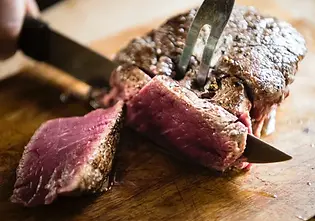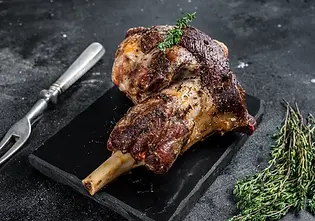Farm Fresh, Regeneratively Grown
Good food and quality products raised the right way – through regenerative farming that leaves the land better than we found it.

Thanks for visiting Guided Rock Farms!
Guided Rock Farms is a first-generation, family farm run by Benton, Christy, Nora, and Naomi. Following regenerative agriculture practices, we raise sheep, cattle, and small grains in the beautiful northwestern Nebraska prairies. We desire to leave the land we farm in better condition than when we began our term of stewardship.
Regenerative practices that are central to our operation include, minimal tillage, no synthetic inputs, use of cover crops for nutrient cycling and weed control, integration of livestock into cropping systems, planned grazing, and animal and plant diversity. Although not certified, we operate according to USDA organic standards. We are a work in progress, and we are growing, and improving everyday.
Want to learn more?

Healthy Soil, Healthy Food, Healthy Lives
As part of our regenerative practices, we heavily integrate livestock into our cropping system. We have fallen in love with the Navajo Churro sheep breed because of their beautiful wool, cultural history, hardiness, and independence. They are a heritage breed and part of the Livestock Conservancy and Shave 'Em to Save 'Em program. We shear our own sheep and love to see the beautiful, regenerative cycle of wool. We are members of The Mountains and Plains Fibershed which helps support regional fiber production by connecting textile artists and designers, ranchers and farmers, mills, and retail businesses.
On the cropping side we focus on crops that do well in the semi-arid high plains, including grains like millet, wheat, barley, oats, and peas. We currently offer Rouge de Bordeaux, Ethiopian hulless barley, millet, and triticale. We are looking to include other heirloom and landrace grains, and perennial grain - and much more; the sky is the limit. Keep checking back for new products.
We know that food grown in healthy soil is healthy food. We also know that the way we farm affects neighbors who live downstream (in our case, down hydraulic gradient), and downwind of us. We strive to love our neighbors by promoting health, both actively (food and fiber) and passively (environmental stewardship).

Our Mission
Guided Rock Farms' mission is to produce agricultural food and fiber products that:
-
Enhance local ecology
-
Use management practices focusing on ecosystem mimicry
-
Are free of dangerous synthetic inputs
-
Are by extension healthier
-
Respect the animals involved
-
You, the consumer, are proud to buy
Products
Explore our range of products, from meats and grains to wool-based items - wholesome, straight-from-the-farm products for you to enjoy.

Standard Beef
Our cattle are raised according to organic standards and using low-stress handling techniques. The cattle are grass-fed and finished, with their diet mainly consisting of native range and cover crops.

Wool & More
Our wool comes from Navajo Churro sheep, known for their coarse guard hairs and fine undercoat. Raised regeneratively, they support ecosystem health. We offer raw and processed wool, yarn, rugs, sponges, hides, and horn buttons.

Highland Beef
This is a premium beef product that takes a bit longer to get to finishing weight. Highland cattle are well-known for superb finishing on grass. Our beef is grass-fed and finished, and they are handled with low-stress techniques. Their diets consist primarily of native range and cover crops. Our animals are also raised according to organic standards.

Grains & Flour
Our grains and flour come from fields that are regeneratively managed, meaning we focus on soil health (see our practices page). In addition to regenerative practices, we grow our grains organically.

Lamb
Our lamb is grass-fed and finished, and they are handled with low-stress techniques. Navajo Churro lamb is lean, yet exceptionally tender. It has a very mild flavor for those who are hesitant to try lamb. They forage primarily on native range and cover crops. Our sheep are also raised according to organic standards.

Eggs
Our eggs come straight from the pasture, or field, where the hens leave their mobile coop each morning to stretch their wings and free-range all day long.
Breeding Stock
Looking to start your own flock of Navajo Churro? We’re happy to work with you and sell breeding stock. Many of our ewes are registered, and those that are not, are registerable. Navajo Churros are great multi-purpose (fiber, meat, milk) breed, with excellent mothering instincts, very infrequent lambing issues, and high parasite resistance. Keep in mind, this breed was developed in the cold, high desert of northern New Mexico, and Arizona, and southern Colorado, and Utah so they tend to be more at home in similar climates (arid, to semi-arid, with cold winters).

Our Practices
Limit soil disturbance
In our livestock production, on the pasture side, there is obviously no tillage. In our crop production, because we farm organically, we use some tillage to control weeds. Our first two weed control strategies are grazing or mowing, and cover crops, but we often rely on tillage before seeding cash crops. When we do till, we make as few passes as possible, we're careful not to pulverize soil, and we immediately follow the tillage pass with seeding so that plants begin growing and covering the soil as quickly as possible after the tillage. We also prefer to use lower disturbance equipment, namely a sweep plow, that does not invert the soil. Sweep plows do not work in all scenarios. We also use strategies like including perennial hay crops in our rotation so that hay fields go several years with no tillage, or double cropped fields where we drill a spring cool-season crop with a winter cool-season crop and have two consecutively harvestable crops from one planting.
Keep the soil covered
We strive to have growing plants or crop residue on our crop ground as often as possible. We plant crops immediately following tillage passes and try to use tools that invert the soil as little as possible. Our first choice for tillage is a sweep plow, which does not invert the soil and keeps residue on top. However, it does not work in all situations and sometimes we need to disk. In either case we seed immediately after tillage to reestablish growing plants to cover the soil.
Maintain growing plants as often as possible
Many of our management practices build off each other and overlap. Similar to other points, we try to have plants growing in our field as long as possible. In a semi-arid environment, this may look slightly different to practices used in wetter climates. Recognizing that more native plants go through dormancy or low-growth periods during hot months, we sometimes also allow short periods (a few weeks to at most two months) of dormancy in our fields. This is more important with grain crops that use more water to produce seed. Native range is naturally very water efficient. Having growing plants is important to support life in the soil, e.g. soil microbes and fungi, which in turn help to cycle nutrients and make nutrients tied up in soil minerals and organic matter available to crops, reducing the need for outside inputs.
Biodiversity
Biodiversity is important to the health of the environment. Our livestock enterprise consists of both cattle and sheep, and the way we manage our rotations promotes plant diversity in our pastures. On the cropping side, we have a diverse rotation that is interwoven with diverse cover crop mixes.
Integrate livestock
Looking at natural systems as our guide, we see that animals are always an important part of the ecology. Grasslands evolved with grazing ruminants. On our crop ground, trying to mimic the prairie, we have our animals graze as often as possible. They fertilize and inoculate the soil with their urine and manure. Even their grazing stimulates plant growth, sending roots deeper into the soil.
Context (environmental, socio-economic, financial, etc.)
Regenerative practices vary around the world based on different climatological, and ecological factors, but the principals are the same. We operate in the semi-arid, high plains of wester Nebraska, and that plays a major roll in our management decisions, placing our focus on livestock and native range, and determining the crops we grow. We are also a first-generation start-up farm, which means we have a very different financial context than generational farms. That plays into our marketing strategy (mostly direct-to-consumer), the products we produce (value-added), and, again, our cropping strategies, growing as many things as possible with as little equipment as possible.










